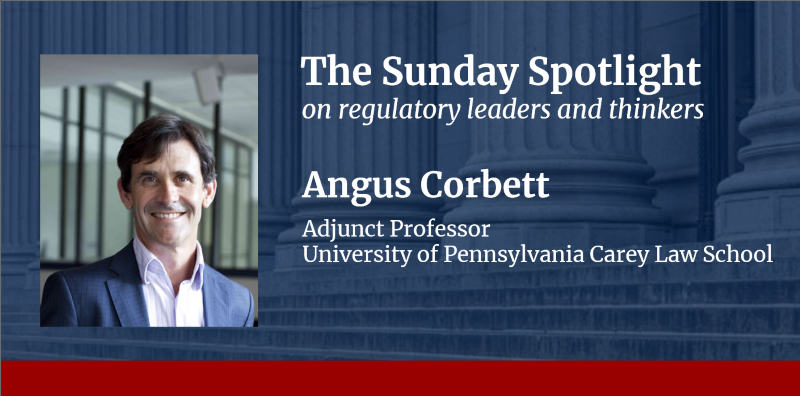
Angus Corbett explores how using comparative analysis of health care systems can inform U.S. health care policy.
In a conversation with The Regulatory Review, legal health care scholar Angus Corbett discusses regulation and policy analysis of the U.S. health care system and argues that a comparative approach to policy analysis could improve the current regime.
A recent Gallup poll reports that public perception of health care quality in the United States is at a 24-year low. Many participants cited unaffordable cost and a lack of access to care as explanatory factors. To address these issues, Corbett argues that policymakers should focus their attention outside the United States.
A successful health care system, Corbett argues, provides individuals with affordable access to quality health care by taking a broad approach that focuses resources on the most serious health conditions that affect the most people. He outlines how regulators can improve a health care system through a “systems” approach under which policymakers develop and apply operational changes on a scale necessary to improve overall outcomes.
Corbett explains that a comparative analysis of health care institutions in other countries could also help regulators solve problems in the United States. For example, he notes that the health systems designed by Germany, England, and Brazil have reduced the cost of care and increased access for their entire populations. These macro health systems, Corbett notes, resemble the micro-managed care systems used in Medicare, Medicaid, exchanges regulated by the Patient Protection and Affordable Care Act, and private health insurance. Corbett argues that more effective regulation of these micro-managed care systems could help Americans access higher quality health care that is more affordable and accessible, but that such changes would be hard won, as all stakeholders would then have less autonomy and choice in how they provide and receive health care.
Corbett is an adjunct professor at the University of Pennsylvania Carey Law School and teaches courses on comparative health care systems and health law. He has published a class on Coursera titled “Comparative Health Systems” and will soon launch a new course titled “Why Is U.S. Health Care (so) Expensive?” Before joining the Law School’s faculty, Corbett served as a consultant on the Health Equity in Housing project at Temple University Beasley School of Law’s Center for Public Health Law Research. Corbett also has held faculty positions at the University of New South Wales, University of Technology, Sydney, and the Australian Institute of Health Innovation at Macquarie University, teaching classes in tort and corporate law and conducting research in health care safety and quality. Corbett participated in the Best-in-Class Regulator Initiative at the Penn Program on Regulation.
The Regulatory Review is pleased to share the following interview with Angus Corbett.
The Regulatory Review: What are the most important defining indicators of a successful health care system?
Corbett: A generally agreed definition of universal health coverage is a good starting point to answer this question. A successful health system will provide affordable and equitable access to health care services that are good enough to improve the health of the communities and individuals accessing these services. This is sometimes referred to as the goal of improving population health, which refers to the state of health of a given population, such as that of a country. The health system will also provide financial risk protection for its beneficiaries so that their need for access to health care services will not tip them into poverty.
A successful health system is therefore oriented toward improving population health by addressing the health conditions that have the most serious impacts on the largest portions of a population. The system aims to improve population health by providing affordable access to care that is good enough to reduce mortality by preventing or treating serious health conditions in ways that improve population health. To provide health care that is good enough, a successful health system must provide health care that is sufficiently equitable, effective, efficient, safe, timely, and patient-centered to improve population health while improving the health of the individuals and communities receiving that care.
The most important indicator of a successful health system is that it is moving toward meeting these goals. For example, a low-income country may be on this path by ensuring that its health system is capable of providing care that is good enough to improve the health of its population through reducing infant mortality or maternal mortality. In contrast, a high-income country will aim to be on this path by providing care that is good enough to improve the health of nearly all individuals in its population in some material way.
TRR: You have written about a “systems approach” to regulation. What is this approach? How can it help to improve the regulation of the U.S. health care system?
Corbett: A systems approach to regulation is one that aims to modify the dynamic patterns of relationships between the organizations and people that make up a health system, with the aim of providing affordable access to health care that is good enough to improve the health of the population served by that health system.
A systems approach both complicates and facilitates regulation. It complicates regulation by requiring an analysis of the potential for using regulation to influence a system’s dynamics to achieve a desired set of goals. It calls on regulators to address the complex problem of learning how to influence the system dynamics that emerge out of the connections, relationships, and linkages between the agents and technologies that constitute that system. Here, it is useful to reflect on the almost unimaginable complexity of the system dynamics that emerge out of the connections, relationships, and linkages between the payers, providers, and individuals in the U.S. health system.
A systems approach also facilitates regulation because that approach makes it possible to test the effectiveness of regulation by assessing whether a particular intervention produces changes in a system’s outcomes. A regulator may form a hypothesis about how a particular intervention will influence a system’s dynamics without having to specify how that intervention will influence every aspect of these dynamic patterns of relationships. The regulator can then use a trial-and-error method to assess whether a specific intervention has the effect of moving a system closer to achieving the desired outcomes.
TRR: Which countries have especially effective health care systems? Should the United States try to emulate them?
Corbett: As Ezekiel Emanuel reminds us, every health system has its own strengths and weaknesses. There is no country that the United States can emulate, but it can learn from the experiences of other countries.
The health systems in Germany and England broadly achieve the goals included in universal health coverage. In both of these countries, lawmakers have used a systems approach to define the boundaries of their health systems by specifying the payers, providers, and people who are entitled to access health care and to design the framework that guides and directs the interactions between these stakeholders.
The United States can learn from this use of a systems approach as it attends to the challenge of learning how to modify the design of managed care to more effectively manage access to health care, its cost, and its quality. Understanding managed care is significant because managed care is now the primary mechanism for providing access to health care for a majority of Medicare and Medicaid beneficiaries and for some 99% of employees who enroll in employer-sponsored health insurance.
The third country is a surprising one. Brazil amazingly learned how to build a health system to provide primary health care services for the vast majority of its population that live and work in the informal economy. The informal economy, which includes the production of market-based goods and services hidden from governments, provides a challenge to policymakers who wish to design a health system that reaches individuals and communities whose activities are otherwise hidden from governments and public authorities. In Brazil and in other low and middle-income countries, informality accounts for significant proportions of overall economic activity. Brazil’s health system is one that the United States can learn from as it seeks to use primary care to provide access to health care for rural and underserved populations who have limited access to hospital care.
TRR: What lessons can U.S. regulators take from a comparative analysis of health care systems in other countries?
Corbett: Comparative analysis of health systems offers the opportunity to work through and resolve practical problems. It can first direct us to learn about what specific institutions in a health system do and how they do it. For example, one of the first challenges of the growing importance of managed care is to learn about its functions and goals and about how it carries out those functions to achieve its goals.
A good starting point is to consider the functions of the system of corporatist self-governance in Germany and of the National Health Service (NHS) in England. An analysis of each of these systems provides a useful starting point for defining the functions of managed care. It is then possible to learn about how the NHS or the system of corporatist self-governance carry out their functions. This involves an analysis of, among other things, the information they need, where they get that information, and how they use that information to carry out these functions.
With this knowledge, it is possible for regulators to begin to carry out one of their most important functions—to learn about what managed care does and how it works. The knowledge gained from the health systems in Germany and England will inform regulators as they seek to learn more about the linkages, connections, and relationships that sustain managed care. This will, in turn, inform their thinking on how to regulate managed care to make it work more effectively.
TRR: What are the biggest obstacles preventing the adoption of universal health coverage in the United States?
Corbett: This will be an odd answer—it is the law. One lesson that we can learn from the health systems in England and Germany is that the NHS and Germany’s system of social health insurance rely on an integrated set of laws to support their capacity to achieve their goals. The various constitutional challenges to the Patient Protection and Affordable Care Act revealed some of the limits of the U.S. Congress’s capacity to use legislation to design a health system to provide access to health care for the whole of the U.S. population.
But your question raises a more immediate problem as lawmakers seek to regulate managed care to move closer to achieving a U.S. version of universal health coverage. Managed care organizations, in conjunction with sponsors and health care providers, design health plans to provide care to defined populations. Lawmakers have enabled managed care to manage access to health care, its cost, and its quality in this way precisely because the authority of managed care systems to achieve these goals relies on the consent of individuals to join the individual health plans that are governed by these systems.
As lawmakers and regulators try to regulate managed care, they will run up against this voluntaristic part of the legal structure supporting managed care. If they are to regulate managed care organizations to achieve fairer and more effective outcomes, they will need to compel those organizations to use their powers in certain, defined ways. As they do this, they will almost certainly encounter legal and practical limits on their capacity to achieve these goals.
TRR: Do you think that the U.S. health care system can be fundamentally changed?
Corbett: My starting point in answer to this question is one of humility. By fundamental change, I take you to mean change that contains the patterns of price and utilization of health care or change that seeks to push health care stakeholders to find ways to reduce the cost of health care, while also improving the quality of health care, with the ultimate aim of improving health outcomes such as life expectancy.
These changes would be fundamental in the sense that they compel stakeholders, including individuals, insurers, providers, and others to engage in the process of providing health care on terms that limit their choice and autonomy. This effect has always been a sticking point in efforts to expand access to health care in the United States.
My aim is to ensure that individuals, providers, payers, and others understand the choices they would be required to make to fundamentally change health care. Each must understand the trade-offs involved in providing better access, improving outcomes, and reducing costs. All too often, the precise costs and benefits of this kind of fundamental change is lost in the flurry of unverifiable, dramatic claims.
TRR: What regulatory mechanisms might enable or prevent managed care plans from achieving fundamental change?
Corbett: It may appear odd to suggest that managed care is a mechanism that could support fundamental change in U.S. health care. After all, it seems to be, at this moment, the chosen institution to manage access to health care, its cost, and its quality. But managed care can become a more effective mechanism to make trade-offs to reduce or control cost, make health care affordable, and ensure that the quality of care is good enough to improve the health of a covered population.
Managed care’s weaknesses lie in the generally small pools of insureds in most health plans, the short terms—usually one year—of nearly all health plans, and the consequent difficulties that managed care organizations have in negotiating with providers and in specifying and influencing what is regarded as the appropriate range of care for particular conditions, illnesses, and injuries. I point to the potential for managed care to become a source of real—and perhaps fundamental—change because small changes in the framework governing managed care may have a disproportionate impact on the capacity of managed care to manage access to care, its affordability, and its cost in ways that improve population health.
The fragmentation of the governance of health care is the main threat to any fundamental change in health care. Managed care may thwart fundamental change because it fragments the governance of health care as it fulfills its responsibilities for managing and administering health plans for defined populations. It operates on a small scale, and its authority to manage health care arises out of the consent of an individual to join a health plan.



